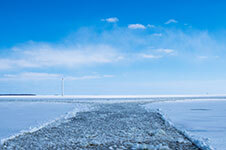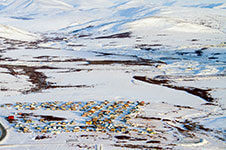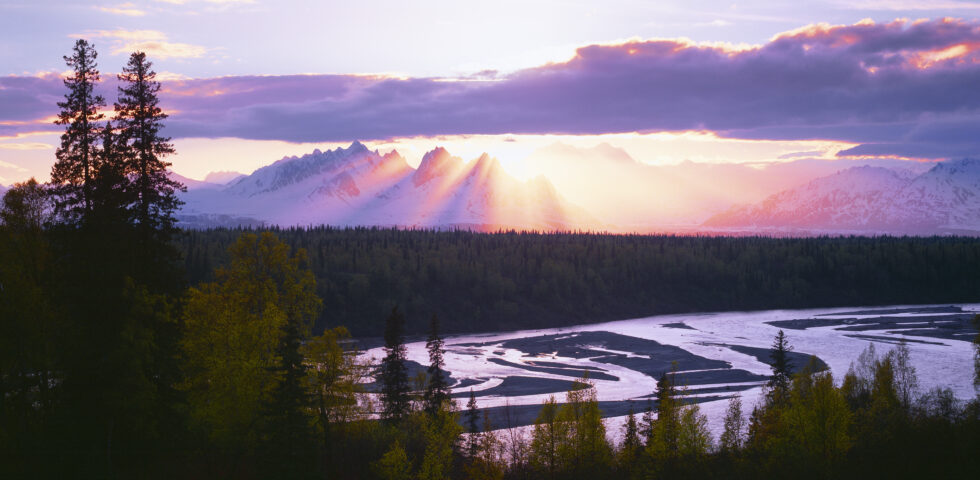Connectivity has been a long-standing issue for the Arctic. For most remote areas in Alaska, not having access to a reliable communication structure leaves communities unprepared to respond to emergencies, hinders communication, and stunts economic growth. Quintillion, a leading provider of high-speed broadband networks based in Anchorage, Alaska, has pioneered efforts to connect the Arctic to the rest of the world by building the first and only submarine and terrestrial fiber optic cable network in the US Arctic.
Installing fiber in harsh Arctic conditions is a true display of our team’s commitment to rural communities, dedication to innovation, and pure Alaskan grit. However, this is only one step one in our multi-phase, visionary plan to build an extensive submarine and terrestrial fiber optic cable network.
Quintillion’s mission revolves around three main goals:
- Expanding In: We strive to connect Alaskan communities across the state by offering affordable and reliable broadband services.
- Expanding Out: We plan to expand fiber routes up to Europe and Asia, strategically connecting the North American Arctic to the rest of the world.
- Expanding Up: We partnered with ATLAS Space Operations to build North America’s highest latitude satellite ground station, reducing reliance on foreign-owned stations.
Here’s a deeper look into what we’ve mapped out for the road ahead.
Need to reach out to our team? Fill out our contact form.
Connecting the Last Frontier: How Quintillion Serves Alaskan Communities
In December of 2017, we finished phase one of the Quintillion project: building our submarine and terrestrial fiber optic cable network. We have been running this network for nearly four years. In that time, rural Alaskan communities have already become more connected.
What We Do
We are a telecommunication operator headquartered in Anchorage, Alaska that provides middle-mile backhaul services for last-mile services providers (including Alaska Communication, TelAlaska, and ASTAC) in our service areas. This means that we don’t provide internet access directly to the public, rather we provide local internet service providers with reliable, cost-efficient, speedy broadband network services that they can offer to customers.
Our infrastructure features a 3-Pair system, which has a capacity of up to 30 terabytes per second and is scalable up to 90 TBps. Its resilient network design includes:
- Cables buried 12 feet below the seabed
- Six cable landings installed 60 to 80 feet deep in steel conduits up to a mile offshore
- Robust feeds and redundant equipment at each landing site
- A 24/7 monitoring and response system
Who We Serve
The Quintillion network is strategically located in the Northwest and North Slope Arctic Region and has already helped connect thousands of Alaskans. It includes over 1700 miles of fiber optic cable, including 505 miles of terrestrial fiber running from Prudhoe Bay to Fairbanks and 1200 miles subsea miles running from Nome to Prudhoe Bay. It currently serves several Alaska communities, including:
- Nome
- Point Hope
- Kotzebue
- Utqiaġvik
- Wainwright
- Prudhoe Bay/Deadhorse
Our service area includes North America’s largest oil and gas fields at Prudhoe Bay, allowing oil and gas producers to better communicate with the outside world, leverage more advanced technology on the job site, and enhance security measures.
How We Help
In today’s tech-driven world, reliable internet and telecommunication systems are necessary to boost economic development and access emergency services in times of need. By bringing high-speed, reliable broadband services to Arctic Alaska, we support local governments, K-12 and higher education institutions, libraries, hospitals, transportations systems, e-commerce, and more. This allows community members access to things like teletherapy, online classes, emergency services, and online shopping.
While Quintillion’s services have a national and global impact, our priority has always been serving our Alaskan community. We are based in Anchorage and partner with other Alaskans who share our mission, including locally based service providers, Alaska Native corporations, government entities, and corporate clients.
Supporting National Security: Why the Arctic Is Critical for Keeping America Safe
The Arctic may be a harsh, cold, and unwelcoming landscape, but it is a land full of opportunity. As temperatures in the Arctic continue to rise, the region is revealing a land rich in oil, gas, and other rare earth materials. These natural resources are vital for fueling many of today’s top industries, including renewable energy, technology, weapon systems, electric cars, and more.
The melting of the Arctic also leaves the United States vulnerable to international adversaries, and new foreign commercial routes can hinder navigation. Quintillion aims to help grow America’s presence in the Arctic and provide the infrastructure necessary to close gaps in national security. Reliable communication is necessary for American success in this region, and our fiber optic cable network is a part of the puzzle. By offering fast and reliable broadband with a capacity of 30TBps (with is scalable up to 90TBps), we can ensure American ground-based defense systems in the Arctic can operate at high speeds when needed most.
As part of this strategic plan to protect the American homeland and aid in securing the Arctic in a political battle against China and Russia, Quintillion plans to extend its network to Europe and Asia in two final phases.
Phase 2: Japan & Asia-Pacific / Arctic Ring
Phase 2 involves creating the Japan-Washington State Trans-Pacific Cable System (JAW TPCS), which connects the United States to the Asia-Pacific. This route will connect to the existing Alaskan network through submarine cables branching from the JAW TPCS to Nome. This final step in this phase is connecting Alaska to the Pacific Northwest with a new cable landing station that’s currently in the planning/development stage.
Phase 3: Alaska / Canada & Canada / Europe
Phase 3 of the Quintillion Network plan is expanding the network from Prudhoe Bay about 350 miles east to a landing at Tuktoyaktuk in Canada. From here, it will extend 95 miles to Inuvik where the Quintillion network will meet with existing fiber optic systems to connect with the rest of the continental United States and Canada.
We plan to build other landings in London and other parts of Europe that are connected through potential landings in the Canadian Arctic. The last stage is creating fiber-optic infrastructure that extends from London to Tokyo with a unique, low latency route.
Progressing Space Operations: What Quintillion’s Arctic Ground Station Achieves
In partnership with ATLAS Space Operations, Quintillion has helped build North America’s highest latitude satellite ground station in Utqiaġvik, Alaska. It is located 320 miles north of the Arctic Circle and is connected to major internet exchanges in the rest of the United States through fiber. It currently operates on S and X bands and is being designed to operate with K band.
The Quintillion-Atlas HiLDA Ground Station is a hallmark of America’s progress in connecting the Arctic to the rest of the world. It is a major step toward increasing national security as US-based companies launching polar-orbiting satellites no longer must rely on foreign ground stations to download and backup data.
Follow Our Progress
Quintillion is proud to be part of such a pivotal movement in connecting and securing the Arctic. We’re passionate about driving economic growth in the Alaskan communities we support and are determined to play our part in improving national security measures in the evolving Arctic.
Want to keep up with our progress? Contact us for more information.















